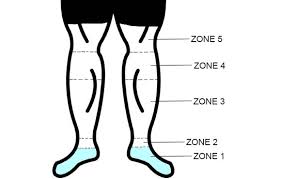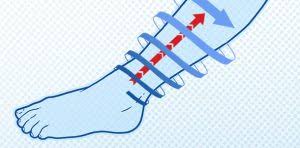
Compression socks come in different pressures to specialize their care.
These different compression levels vary in popularity but can all be helpful in alleviating pain and swollen legs.
The benefits of compression therapy are plentiful and vary from person to person. This page will show you the compression stockings mmHG chart and differences in usage based on pressure rating.
Using the wrong compression level can cause more problems.
Let’s find you the perfect compression level (mmHg pressure).
Compression socks are used as a preventative way to maintain healthy legs and feet. This can be especially helpful for people who spend an extensive amount of time standing. When a person stands for a long period of time, the force of gravity increases the pressure within the veins of the legs. This brings the greatest pressure at the ankle and decreases as you move up the legs and body. This pressure depends on the vertical distance of the column of the blood from foot to the heart.
This is why gradient compression socks are designed with pressure that is greatest at the ankles and decreases as it goes up your legs. This gradual pressure counters the effects of the high venous pressure.
Some conditions which benefit from compression therapy include:
- Lymphedema
- Pregnancy-related swelling and vein problems
- Poor circulation from sitting for long periods
- Swelling, blood clots or pain in the lower legs, including DVT(Deep Vein Thrombosis)
- Post-surgical and post-sclerotherapy treatment
- Varicose veins
Using compression socks
Compression stockings are worn in the morning when you wake up and get out of bed, before any swelling can occur. These socks should be removed at night before you jump into to bed. Throughout the day, the compression therapy prevents blood from pooling in the leg veins which in turn helps the overall blood circulation and lowers the chances of any leg swelling.
When shopping for compression socks, make sure to measure your legs early in the day before any swelling builds up in your legs. Measuring your feet later on in the day may result in choosing socks that are too large and therefore not effective for your therapy.
There are many different types of compression stockings available in the market and you can get these without a prescription. Lower compression strengths can be purchased over the counter. Socks with stronger compression levels may require a prescription.

Understanding compression stocking strength
One of the confusing aspects about choosing the right compression socks is in understanding the level of pressure they provide. Compression socks have different levels, which indicate how much pressure the garment provides to the feet. The standard compression levels for compression socks include 15-20 mmHg, 20-30 mmHg, 30-40mmHg and 40-50 mmHg. The 15-20 mmHg socks are the lowest strength and can be purchased over the counter at a local store. The other strengths and considered to be medical resources. The 20-30 mmHg socks are considered medical class one, the 30-40 mmHg socks are medical class two and the 40-50 mmHg socks are medical class three. There are other compression levels as well, but these are the standardized compression strengths and are commonly used.
What do the compression levels mean?
Compression levels are indicated with a range of numbers like 30-40 mmHg. This means that the amount of pressure will not fall below 30 mmHg and will not exceed 40 mmHg. mmHg is the unit used to measure pressure and is called ‘millimeters of mercury’. This unit is also used to measure blood pressure.
The graduated features of compression socks make them versatile and helpful with different pressure levels. This special design helps in blood circulation move up your leg. There would be devastating effects if graduated socks work in the opposite direction, with pressure highest at the top and lower at the bottom. That could hinder blood circulation, which is why it is so important to buy compression socks from reputable brands such as Comprogear.
So what’s the difference between all of these different strengths of compression socks? Here we share some important things to know about each level.
Getting the Right Sock Strength For You
One of the many great things about compression socks is how they can come in different strengths and styles.
When selecting a compression strength for your hosiery either for traveling or for support while working, make sure you consult your doctor for recommendations. It all depends on your situation and a lighter compression level might be effective than a stronger compression.
There are dire consequences to wearing the wrong compression stocking which may include irritation or redness which may be brought about when your stockings are not fitting perfectly or you not putting on the socks correctly. Other side effects include you having an allergic reaction to the stocking material.
Most importantly, make sure your compression socks fit properly. Bodies come in different shapes and sizes, so compression socks also come in different shapes and sizes. You need the right size compression socks to start with. Check out this compression sock size chart for details.
It is also important to replace your compression stocking every five or six months to assure that they maintain a proper compression level or shape. If they start to lose compression pressure, then it is time for a new pair.

15-20 mmHg – Over the Counter
A low level of compression, such as 15-20 mmHg, is a wonderful choice for everyday compression socks. These socks can help with mild swelling and fatigue due to standing for long periods of time or from sitting on an airplane for a long time.
The 15-20 mmHg graduated socks come in various styles, including thigh-high, knee-high and maternity pantyhose. These socks are available for both men and women. You can also choose from different colors and patterns. These socks are casual everyday stockings designed to resemble dress or casual cotton socks. You can even find sheer fashion styles! At this mild strength level, you can also find athletic compression socks to help with recovery and performance.
A lot of people choose to wear the 15-20mmHg strength level for traveling or flying. These socks can certainly be very comfortable, and there are numerous styles available. More and more people are choosing to add 15-20 mmHg compression socks to their lifestyle. These socks are easy to get, as they do not require any medical prescription and can be purchased at any pharmacy or online store.
Moving up from the 15-20 mmHg level strength is the 20-30 mmHg level sock. These socks are the most used medical-grade compression socks because it provides competent compression to legs without being too strong. The 20-30 mmHg compression strength is wonderful in compression therapy, treating varicose veins, pain in traveling, performance and recovery in sports and alleviating lingering effects from surgery.
20-30 mmHg Medical Grade Class 1

Pregnant women also can find compression stockings to be beneficial. They may choose to wear the 20-30 mmHg to alleviate heaviness, swelling and pain in their legs. The 20-30 mmHg compression strength is also available in different styles for both genders in knee-high, thigh-high and pantyhose. Other distinct styles you can get include fashionable stockings, dress socks style, sports sock styles and opaque styles.
30-40 mmHg Medical Grade Class II
The 30-40 mmHg compression strength is a stronger medical-grade sock. It is recommended for venous deficiencies that range from moderate to severe. The 30-40 mmHg compression level is recommended when you have a blood clot or deep vein thrombosis (DVT). Patients with lymphedema are also recommended to use the 30-40 mmHg compression strength.
When choosing the 30-40 mmHg compression level, make sure to consider the fabric of the compression socks. The fabric is important in determining comfort because the compression stockings are providing more compression in the 30-40 mmHg compression. As a result, you’ll need a more durable material.
This medical grade sock is prone to snags and holes due to the pressure it puts on on the legs. Picking a stronger sock material will help in preventing those holes.
40-50 mmHg Medical Grade Class III
For severe issues with blood flow and leg and foot pain, the 40-50 mmHg pressure level socks can help. It’s the highest pressure sock available. This level of compression strength cannot be purchased over the counter. You’ll need to get a medical prescription and proper fitting. It is recommended that those considering using the 40-50 mmHg compression strength should thoroughly consult their healthcare provider about the compression stockings and their health and mobility. These medical grade class III socks are used to treat things like severe venous stasis, wound management and lymphedema.

Related Articles
- Sock Soothers
- Compression Sleeves for Legs
- Medical Compression Socks
- Compression Socks for Men
- Best Compression Socks for Swelling
- Can You Wear Compression Stockings 24 Hours a Day
- Toeless Compression Socks
- Thigh High Compression Socks
- Easy To Put On Compression Socks for Elderly
- Do Compression Socks Help Gout
Choosing compression stockings can be difficult without prior research and experience.
That’s why it’s important to know what the different levels are and what is best for your health.
Each level of strength can be helpful for leg and foot circulation when it comes for traveling, recovery or other types of medical therapy.
Compression socks come in different styles and designs which you can purchase online or from your local pharmacy.
If you have a medical condition and are in need of compression socks, your doctor is the greatest resource for compression socks. However, if you are getting compression socks for traveling or support when working then the lighter compression level stockings are perfect and you do not need any medical prescription for these.
Find your way toward better health with the help of compression socks designed just right for you.
This page last updated December 10, 2022
